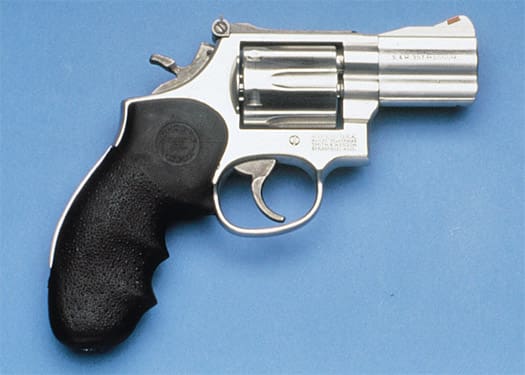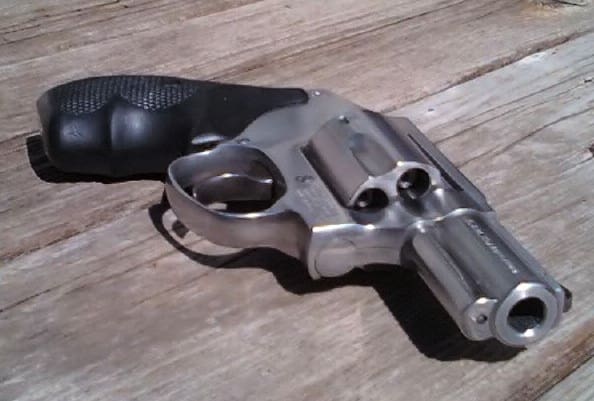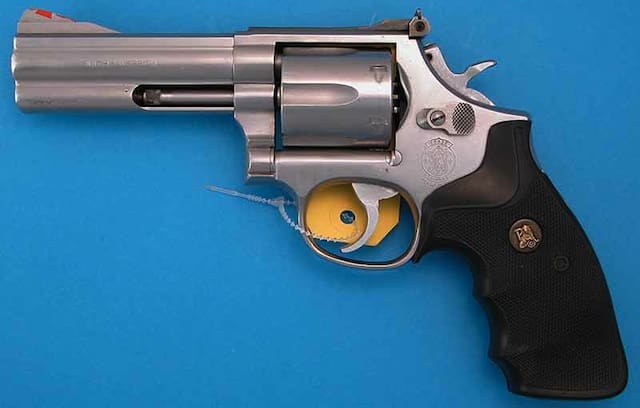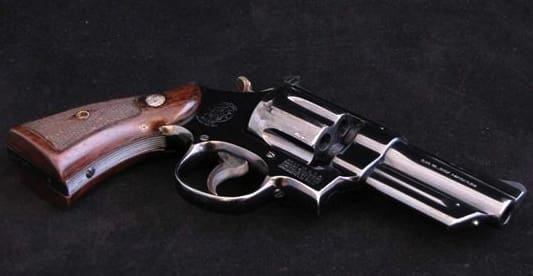Fearless Leader recently posted Another Reason Why the Smith & Wesson 686 Is the Greatest Gun Ever Made. I’m a wheelgunner myself, so I’m sort of picking nits here. But Grandpa Wenger’s favorite saying was, “differences of opinion are what make horse races” and this was a man who had actually supplemented the family income by betting on the trotters during the Great Depression . . .
My first .357 Magnum was purchased in the panic in California, in late 1982, when the passage of Proposition 15 would have meant no more sales of handguns to private citizens in that state. Fortuitously, Prop 15 was defeated by a margin of about two to one but lots of us made hurried purchases in the month before the election. Some friends at work were fond of the Ruger Security Six and an article by Chuck Taylor had erroneously convinced me that one might just barely gain some advantage from a .357 Magnum with a six-inch barrel.
I purchased a blued six-inch Security Six, a gun I never really took a shine to. About a year and many gun rags later, I decided to sell it and replace it with a four-inch S&W 27. When I got to the counter at the gun shop, the 27 did not feel as nice in my hands as I had expected so the clerk pulled out a four-inch 586. I liked the more muzzle-heavy feeling and that was what I purchased.
A few years later, I read an article by Massad Ayoob, in which he sang the praises of the 2 ½” 686, so I bought one. I know that the book says these were not introduced until 1990 but that was one of two guns I took to the LFI-I course in November 1988, only to have Mas tell me all that was wrong with that model. Despite his having compared it favorably, in his article, to a three-inch 66 – a non-catalog version that was offered periodically through a couple of S&W distributors – a few years later I found that I disagreed. The lower bore axis of the K-frame revolver produced less muzzle flip in my hands, even with the hot 125 gr. Federal SJHP Magnum loads, and the full-length ejectors with their N-frame-style housing on the three-inch guns suited me fine.
Still under the Ayoob influence, after some disappointment with one of the first “two-inch” Ruger SP101’s chambered at the factory in .357 Magnum – back when the marking still specified “125 gr. bullet” – I ended up carrying a pair of S&W 640-1’s in mirror-image fashion, on the waist. Many years later, I finally figured out how to empty out my left, front pants pocket so that I could add a slightly lighter “no-dash” 640 there.
By this time, I had already lost my infatuation with the Magnum chambering for self-defense, for a variety of reasons, including concerns with excessive blast from the muzzle and the barrel-cylinder gap when firing from the compressed position I think are most likely to be used off the range. Were I starting anew, knowing what I know now, I’d carry a pair of three-inch revolvers on the waist but don’t feel strongly enough about it to spend the money on a new set of holsters.
Don’t get me wrong. I think that most of the L-frame S&W revolvers are fine guns. Had I ended up joining the Arizona Rangers – a group of volunteer security officers who work public events – I would likely have bought a duty holster for the four-inch 686 that replaced that 586 that I gave to my son, after he used it to take the LFI-I course.
But seriously, as they say, if I could only own one handgun, I have no doubt that it would by my childhood dream gun, It took me ten and a half years of Arizona gun shows to locate one but my search paid off. I’m talking about the 3 ½” S&W 27, a gun that, in its day, was de rigueur for Special Agents of the FBI. Yes, the round butt on the three-inch 66 feels a bit better in my hand but, once that large N-frame cylinder starts rotating, that’s about as sweet a trigger stroke you can find on a S&W revolver. And the N frame will comfortably handle anything from .38 Special wadcutters to .357 Magnum hunting loads.










I can actually make a very good case for the Ruger GP100 as the best general purpose 357 of all time.
True, out of the box it's not very refined. It needs some tuning and spring work to feel right, and if you have that done professionally you now have a gun that will cost as much as a new 686.
But, you get some damned interesting advantages.
It will hold up better under rapid-fire with light loads than anything in S&W's catalog. It will trounce the 27 in that regard, because the big heavily cylinder on the 27 or 28 (or earlier N-frame 38s and 357s) doesn't want to start and stop quickly under those conditions. High-speed shooting of light loads is the N-frame's kryptonite and will tear up the action over time. This is why the PPC guys used to add weight to 38Spl K-frames instead of starting with the heavier Ns.
A GP100 can be field-stripped without tools, save for the one screw needed to get the grip panels off. Once the grips are off a factory-supplied take-down tool can be found inside one grip panel.
A GP100 locks the cylinder in place at the crane as well as the cylinder's rear end, something S&W hasn't done since the triple-lock (and possibly the X-frame, I don't know about those). In an overcharge situation this can hold the cylinder in place long enough to get the round out and either eliminate or minimize damage that would kill a K-frame dead and likely harm an L or even N.
The GP is big enough to shoot the nastiest possible 357 factory loads (as is, admittedly, an L or N) but also has a strong set of action parts. It has no sideplate that can blow out. The bolt stop notches on the cylinder are offset from each chamber bore center, reducing the cylinder weakness at that point.
The ergonomics are extremely tuneable for any hands. The "grip frame" is just a stub with a spring in it, with the grips filling in everything else. A huge variety of grip sizes and types are available, unencumbered by the shape of the underlying metal. Since it takes the same grips as the SuperRedhawk, huge oversize grips are available and the radical Badger grips for the GP100 have to be seen to be believed.
Finally, Ruger barrels are quite good – basic accuracy of a GP100 tends to be good, and the Rugers "spit fast" for their barrel length. The latest S&Ws have caught up in this area, at a cost in unreliable locks, MIM parts and the like.
In short, it's only "flaw" (slightly funky trigger out of the box) is easily corrected. Other than that it's a modern design that balances compact size, action strength, "blowup resistance strength" and "enough weight to cope with major loads" very well.
I own a 6" 686 that I bought in about 1987. It (like all the guns I bought back then) was bought to be used strictly as a target gun. The fit and finish of the gun was flawless. It was very reliable unless it got very dirty. It actually did jam a few times on some dirty reloads I bought from my local gun shop. As for the trigger, when fired single action, no gun came close, even other S+Ws. It is almost thought control. Just a slight pressure and bang. If you did your part, the gun was capable of very impressive groups. In all, a very nice gun for shooting loads of any power level.
My buddy from work (after shooting my 686) decided to buy a revolver. He chose a Ruger GP100. His was a 4" that he intended to keep in his truck. His was completely stock when I shot it. The first thing you notice about Ruger revolvers is the weight. His 4" weighed more than my 6". We all know the benefits of a heavy gun for soaking up recoil from heavy loads, but this was too much. This thing was just heavy. The trigger was good, but nowhere near as good as my 686. When fired double action, the smith was smoother, but in a combat situation, I didn't see enough difference to matter.
The Rugers seem to have shed some weight over the years. Maybe the weight gap has closed over the last 20 years? The Ruger's quality and value has never been in question. Im not sure what made me buy a Taurus model 66 with a 4" barrel, but maybe I liked the idea of the shorter barrel, but not the weight of the GP100? The 66 is the Taurus version of the 686 with the transfer bar ignition. My Smith has a hammer mounted firing pin. I wont delve into the history of Taurus and its relationship to S+W, but its interesting to see the family resemblance.
I think both are good guns in their own right. If I was to carry a revolver every day, a 4" 686 (like the one above) would be my first choice. Maybe a GP101 for backup. Alas, I don't shoot the revolvers much anymore. I have a trio of high tech plastic wonder guns to choose from for carry. Times change, and needs change too. However, the revolvers will always occupy an honored position on the top shelf of my safe.
Comparing the various virtues of the many Smith & Wesson revolver models is such great fun! Every frame size includes one (or several) truly historic and iconic firearms, and each of them were damn-near perfect for their jobs in their day and time. Most of them, including mine, still are.
RB: Regarding Taurus and S&W, although Taurii look similar to K-frame Smiths, I believe if you take off the grips you’ll see that it has a coil spring vs. the S&W’s leaf spring. IMO it is the leaf spring that makes the S&W K, L, and N frame revolvers such a joy to shoot.
I am with ya, daddy-O… my vote goes to my Model 27-2 3.5″ Blue… sweeeeet. I love my 4″ Model 581 No dash too, but the pinned and recessed 27 runs like a fine Swiss watch. I never warmed up to Rugers… the SP101 is a well made gun, but the trigger was made for a nervous gorilla… Skoal!
Nothing beats a Pre 27 3.5.” The Smith N frames are the only revolvers I really like other than the diminutive J frames. They just feel and balance right, especially in a tapered barrel. The 27’s in a 3.5,” have perfect proportions. I believe the classic 27’s in general are the best there’s been in double action revolvers.
Sure, if you want a tool, buy a Ruger. For something elegant and functional, it’s S&W all the way.
For the most versatile, I believe that honor goes to the 45acp revolvers.
Interesting you should say that… I just this last week traded a little 617 Airlite .22LR 8-shot straight across for a M625JM (Miculek) 4″… thought I really made out on THAT one! I thought I would sell it, but it is growing on me fast… if it shoots like I think it will from the feel… I plan to put some big hardwood grips, S&W medallions (from Thailand/ Ebay) on it, as the factory grips are interesting but, for me, too slim… and keep it… double action is very smooth… single action is typical… great… points really well too. Hate the lock, but oh well… also love the gold front bead sight. The thought of a couple of 230gr Gold Dots in a BG’s belly is ghastly… but bearable. Doubt if it will replace my 686+ no lock 4″… but so far I am impressed!
I own a Colt Python 4″ Blued, a Model 27 3.5″ Blued, a S&W 586 Blued, and a Ruger SP101 2″…my first revolver was a 4″ GP100. There’s a few reasons I don’t own the GP anymore…
Trigger-good, not great. HEAVY.
Over-built: to some a good thing, but to me was just too bulky and heavy. IMO to avoid heavy recoil don’t shoot heavy loads. Shoot what’s comfortable-so your gun can be comfortable too. Again MY opinion.
I don’t dislike the GP-but compared to the others I own (listed above) it’s not in the same league. It’s a toss up between the Python and M27 as to which is my favorite. I love them both!!
Comments are closed.